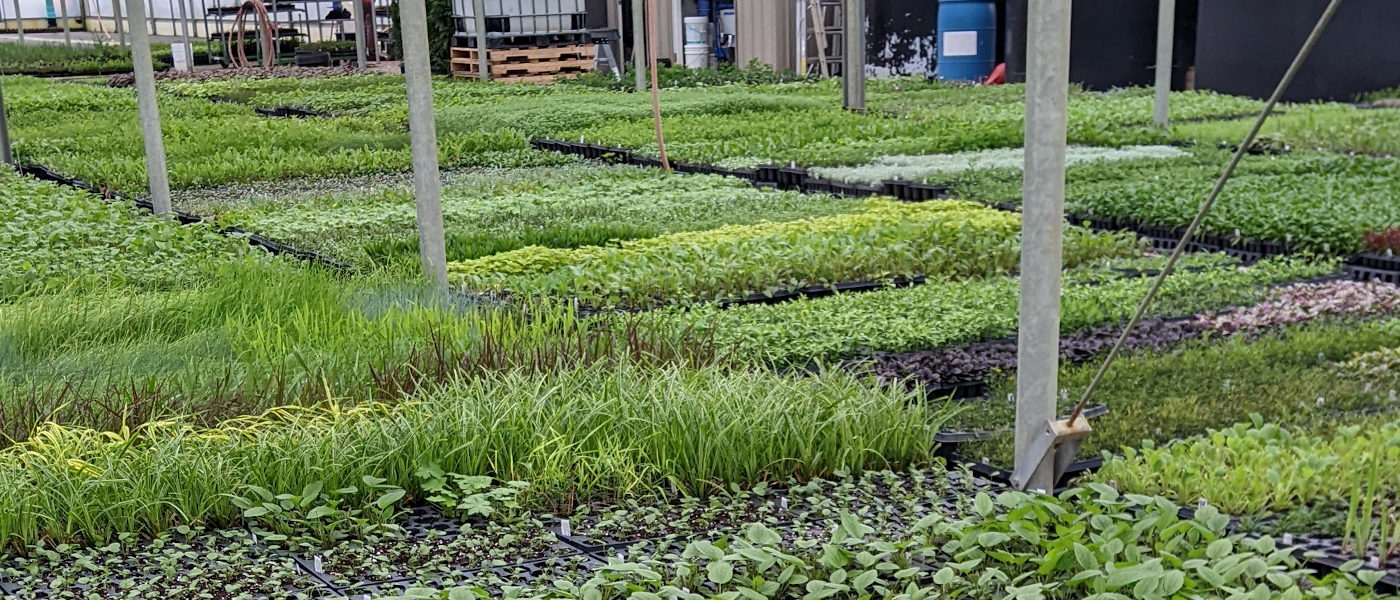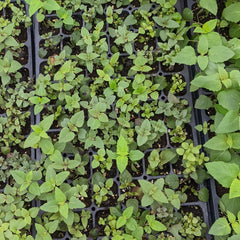Menu

Greenhouse Tour
Where do our plants come from
Have you wondered how we get these beautiful plants. Who grows them? How are they started? This week we had the privilege of a behind the scenes tour at our grower's greenhouse.
Entering the Greenhouse was a blast of spring
It smelled so good. It was so green as far as you could see! I just wanted to breathe, and my skin felt like it was absorbing moisture it hasn't seen all winter. At this time of year your plants are still TINY. They are in trays of 72 plugs. That's 72 plants for every 20"x10" space on the floor of the greenhouse. There are multiple greenhouses!
How are the plants propagated?
Our grower starts plants via 4 different methods.
Seeds

Many plants, including almost all of the native plants, are started from seed. Here is a trays of Anise hyssop and Beebalm that were started from seed. We were told that usually they put 2 seeds into each cell, to ensure plant growth. One of the challenges they face is seed quality. If they get seed with a bad germination rate, then you can imagine that the process needs to start all over again and there simply isn't time in the schedule for that. It takes 6-8 weeks in these small plug trays before the plant is ready to be transplanted into bigger pots. Seeds are particularly preferred for native plants, as the diversity of genetic material is maintained in the seed stock. Where possible seeds for native plants are sourced locally, but it isn't always possible yet as this side of the industry races to catch up with demand for native plants.
Cuttings

Many plants are cultivated from cuttings. In some cases the mother plant is kept at their own nursery and they make their own cuttings. But, also, there is a large business of tiny cuttings supplied to nurseries all over the world, especially for trademarked plants. The cuttings may be tiny, as in this picture. It is dipped into rooting hormone, and then planted in plug trays to root out and get started. This process results in all the plants being genetically identical.
Bare Root Stock

Some plants are purchased as bare root stock from other growers, and planted up into pots ready for the spring season. This is just how some plants propagate themselves naturally. If you have ever grown irises, you know that they tend to expand prodigiously via rhizome. Those can be dug up, cut up, and each made into new plants. Again, in this case, the genetic material is identical to the parent plant.
Other People grow some plants

In order to provide the full catalogue of plants, some of the plants we sell are grown by others, and purchased, by our grower. This is particularly the case for plants that require a special environment, or schedule, in order to grow. For instance, this week they received some of their hellebores, in full bloom, from another grower. This is surprisingly common for green houses behind the scenes. Some people are just better at, or prefer to, get more excited by some plants than others and end up specializing.
How fast can I get my plants?
When I saw how tiny the plants are right now, in early March, I wondered right away what is the timeline to get these big enough for sale? After these grow up a bit more, they will be transplanted into larger pots for sale in the spring. The fastest and healthiest way to do this is by moving them from tiny plugs, to larger plugs, to bigger pots as their roots fill in the soil. It is very labour intensive! For most plants, it takes 6-8 weeks for them to be big enough for their first transplant, and another 4-6 weeks to get to a salable size. Of course, that depends very much on the type of plant. Some plants were planted last fall, and have been in cold green houses, some are starting now from seed, some are being grown from cuttings, some are being grown from bareroot stock. My head just swirls! It never ceases to amaze me the knowledge and care that goes into growing plants for our gardens. Behind the scenes there is a huge schedule for each of the 1200 plants our grower brings to market.
- Choosing a selection results in a full page refresh.

